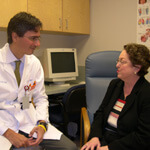
San Antonio (Dec. 6, 2004) – Three months ago, 51-year-old Kay Frost waited in line for a lifesaving lung transplant. Just six days after being placed on the waiting list, she had a new lung and a new lease on life. Now she’s looking forward to waiting in lines at local malls to do her holiday shopping. “No line is too long for me because I’ve been given the greatest gift of all – the gift of life,” she said.
But if it hadn’t been for the short waiting period to receive a lung transplant at The University of Texas Health Science Center at San Antonio, Frost said she may not have been around to spend Christmas with her family this year.
The Health Science Center’s lung transplant program has the shortest waiting period for lung transplant surgery in the nation. The average national waiting period for a lung transplant is two years. At the Health Science Center the average waiting period is 44 days, but many transplants, such as Frost’s, are performed sooner than that.
A study conducted by Luis Angel, M.D., director, and Stephanie Levine, M.D., co-director of the lung transplant program at the Health Science Center, determined that lungs from “marginal donors” (donors who are over the age of 55, who have a history of mild to moderate smoking or pulmonary disease, or who, at the initial evaluation, did not have ideal oxygen levels, clear chest X-rays or a normal bronchoscopy) could be used effectively in transplant surgery.
Dr. Angel worked with Joe Nespral, director of clinical services at the Texas Organ Sharing Alliance (TOSA), to implement a new lung management protocol. The new protocol significantly improved the performance of marginal lungs.
“With the new lung management protocol in place, the number of TOSA-procured lungs transplanted has jumped from 16 in 2000 (the year before the study began) to 43 in 2003,” Nespral said. “That’s an increase of 169 percent in three years. Last year, lungs accounted for 12 percent of the TOSA organs transplanted.”
Nespral said the successful lung program is good news not only for San Antonio patients, but also for lung patients across the nation. Of the 43 TOSA lungs transplanted last year, 31 went to local patients and 12 to out-of-town patients. Nespral said the new protocol has made TOSA’s lung procurement rate one of the highest in the nation.
“Of all the major organs, probably the most difficult to recover and transplant is the lung,” Nespral said. “Because of the shortage of donors and transplantable organs in the United States, organ procurement programs are constantly looking for ways to make more organs available for transplantation. By liberalizing the criteria for lung donors, and by working with the Health Science Center’s transplant team to improve and maintain every donor, we are saving more lives without putting patients at risk.”
Frost said she was so thankful for her new lung that she gave it a name – “Dora.” This year she plans to surprise her daughter, Jennifer, and 1-year-old grandson, Blaine, by decorating her Christmas tree in a “Dora the Explorer” theme. Dora the Explorer is an animated character from Nickelodeon Junior TV.
“My new lung, Dora, is going to help take me on some new adventures in life, and thanks to the Health Science Center I’m happy I’ll be able to share them with my family,” Frost said.

